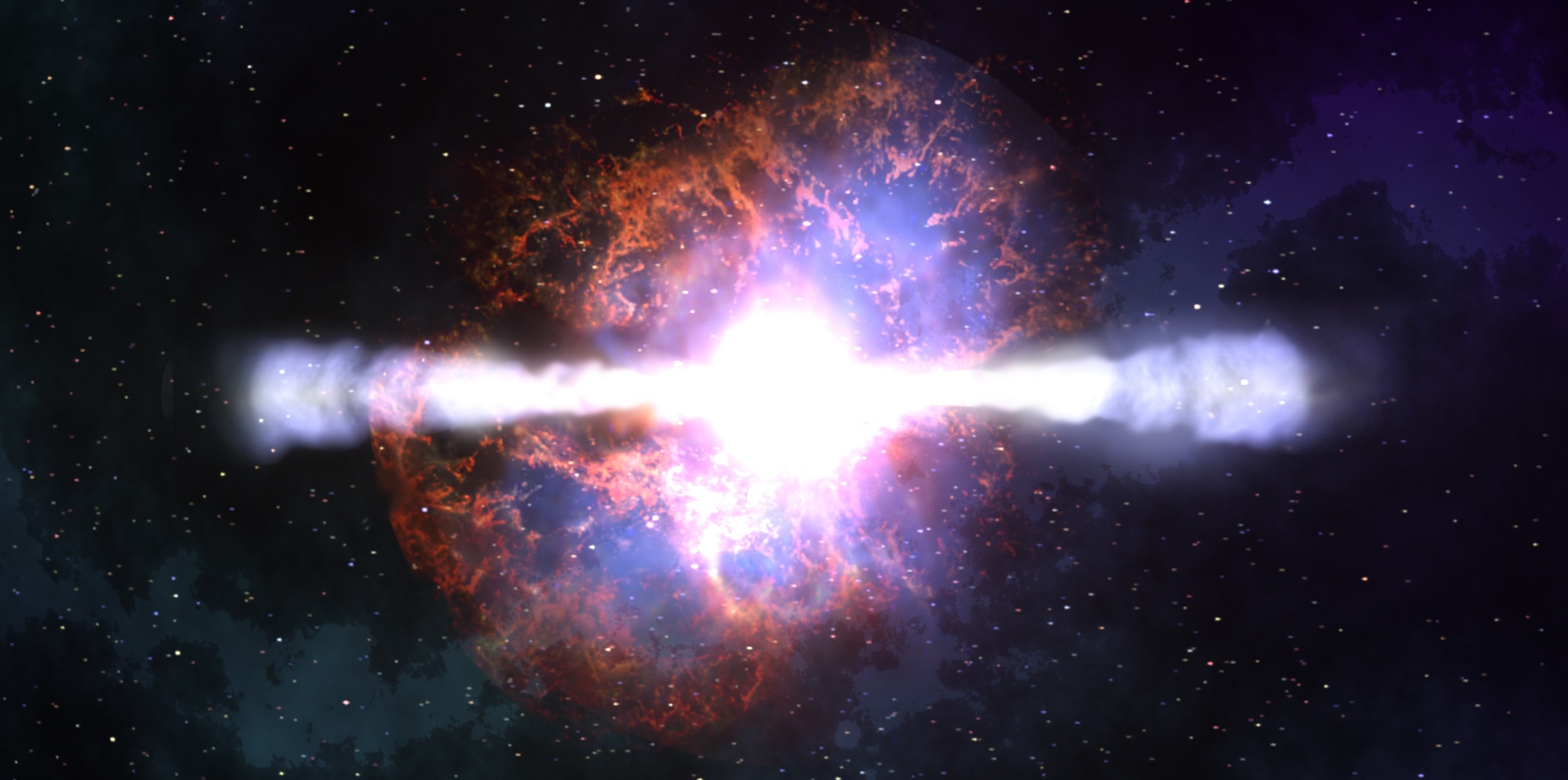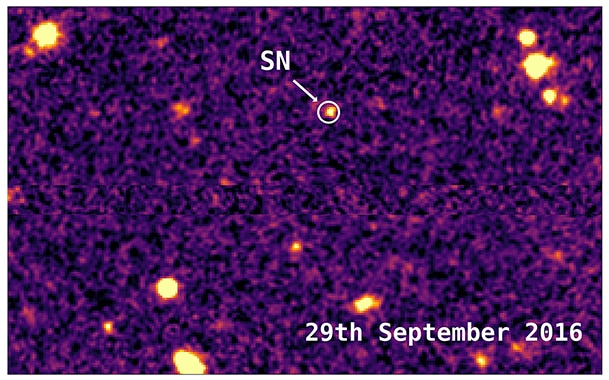Create a free profile to get unlimited access to exclusive videos, sweepstakes, and more!
A superluminous supernova seen more than 10 BILLION light years away!

Astronomers have found one of the most distant exploding stars ever seen — the light from the colossal event took a staggering 10 billion years to travel across the Universe to reach us! And, like so many of its brethren, it will help us understand why these stars explode, what kind of environment they grew up in, and maybe even how the Universe itself has changed over the eons.
The supernova is called DEC16C2nm, and was seen in images taken for the Dark Energy Survey, a huge project that maps millions of distant galaxies over 5,000 square degrees (about 1/8th of the whole sky!) to better understand the structure of the Universe. Because it takes such deep images, it will catch lots of stars exploding over time … and over space.
This supernova was first seen in images taken in August 2016. Once it was discovered, astronomers looked in earlier data to see if they could spot it, and it might have been seen in observations taken as early as March, but definitely not in February. It reached peak brightness in September of 2016 and has been fading since.
But its brightness is a key issue — how bright a supernova gets depends on what kind it is, and how far away it is from us. Without the distance, it's hard to be able to apply much physics to it.
The best way to get the distance is to measure its spectrum — break the light up into individual colors and examine them. As the Universe expands, we see more distant objects moving away from us faster, and this changes the wavelengths of the spectrum, making them longer. This is what we mean when we say the light is redshifted.
Spectra of DES16C2nm were taken in October 2016 using the huge Magellan telescope, and displayed some evidence that the supernova was at a high redshift, meaning it was very far away. More spectra taken using the monster Keck observatory in Hawaii and Hubble Space Telescope confirmed it: The wavelength had been shifted by a factor of nearly three; using the terminology of astronomy, we say it has a redshift (denoted by the letter z) of 1.9982. When you do the math, that means the light traveled for over 10 billion years to reach us*.
Now that astronomers had the distance, they could go back and look at how bright it got, and they found out it was about 100 times as bright as a normal supernova! That means it's in a rare class of exploding star called a superluminous supernova, or SLSN.
These are stars that start out life very massive, and burn through their nuclear fuel very rapidly. Usually in a million years or so they run out of fuel. When that happens the core collapses, and that releases a vast amount of energy. In a normal supernova like this, the explosion is so powerful the outer layers of the star are blasted away, and the release of energy is so huge that it's equivalent to the Sun's entire lifetime output!
But these superluminous ones are even more powerful. It's not clear why. One idea is that when the core collapses it forms an extremely hot and dense neutron star. These have phenomenally strong magnetic fields (trillions of times stronger than Earth's), and this beast is fed by the material falling onto it from the collapse of the core. The resulting interaction hugely amplifies the explosion, creating the vast energies of a SLSN. Another idea is that it could be a pair-instability explosion, or that the ejected material slams into gas in its host galaxy and lights it up.
The thing is, these powerhouses are rare, so we don't have too many to study, making it hard to know what's what. Every one we find like this helps.
But interestingly, this very distant SLSN is pretty similar to ones we've seen that are much closer to us. Remember, this explosion took place when the Universe was much younger, which implies the conditions back then to make these kinds of stars were similar, too. So right away that helps astronomers better understand what things were like in galaxies billions of years ago, something extraordinarily difficult to do otherwise. Galaxies that far away are faint.
Speaking of which, the Universe is only 13.8 billion years old now, so this means that supernova went off when the Universe was less than 4 or so billion years old. Looking at the capabilities of current and future observatories (including WFIRST, a potentially amazing mission that Trump's NASA budget cancels), the astronomers who found this SLSN calculate that they may be able to see them much farther away, catching them more than 12 billion light-years distant. That's edging back to when things were pretty different in the Universe, so keeping our telescopic eyes open for this type of explosion is well worth our time.
One thing I do want to note: I'm seeing a lot of news sites saying this is the most distant supernova ever seen. But that's not true. It's the most distant for which we have direct spectroscopic confirmation. At least two other supernovae have been spotted that were farther away (10.5 and 12 billion light-years), but those distances were found long after the fact by measuring the redshifts of their host galaxies. The difference is important to astronomers; the capability of getting spectra while the supernova is still an ongoing event allows us not just to get the distance but also to understand the chemistry of the expanding supernova debris (for example, DEC16C2nm had no hydrogen in its spectrum, which indicates the massive star blew off most of its outer layers before it went kablooie, and that tells us a lot about what it was doing in the years before the explosion).
So have a care when reading news stories about the most distant this or the most powerful that. While the actual cases may be more subtle, I think it's important to understand what's really going on.
Because what's really going on is amazing. Detecting supernovae this far away is something we've only been recently able to do, and it's opening up a new world — a new Universe — of understanding. We're peering farther into the cosmos than we ever have, and we're always pushing farther. Humanity has always been curious about how we got here, and why things are the way they are. These are some of the most fundamental philosophical questions we have.
And we're getting closer to answering them. Science! I love this stuff.
* Some people say that this means the supernova is 10 billion light-years away. This gets into semantic stickiness quickly, but it really means the light traveled for 10 billion years. The Universe is expanding, and so the supernova was much closer to us when it went off, and has traveled farther away in the meantime. What we think of as "distance" gets tricky when you're talking about cosmological scales.



























